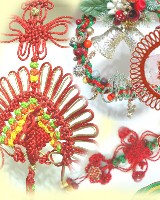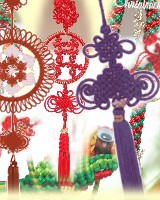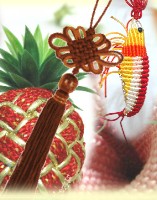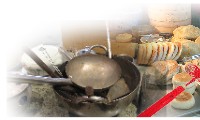 |
 |
 |
 |
| |
Chinese knotting presents the ¡§form of beauty¡¨ and ¡§ingenious structure¡¨. Behind the time and effort consumed, its underlying meaning is purity, nature, and skillful hands that cannot be replaced by machine. Combined with different knots or other lucky symbols, it forms an unique and meaningful traditional lucky decoration. |
|
|
|
The word ¡§knot¡¨ represents power and harmony in Chinese. It is full of feelings, such as combination, making friends, marriage, union, united, or a married couple, or forever love, etc. It brings the feeling of reunion and intimacy. In addition, ¡§knot¡¨ sounds like ¡§luck¡¨. Chinese knots as ornaments bring good luck. Therefore, this energetic local crafting has become part of the traditional culture. |
|
Human know how to knot long time ago; ¡§knot¡¨ always plays an important role in Chinese life. The reason why ¡§knot¡¨ is so important is because it is a useful skill. When there's no written Chinese characters, ancestors even used ¡§knots¡¨ to communicate. For example, ¡§Yi-Jing¡¨ (the Book of Changes) mentioned ¡§ancients took notes by knotting; descendent saints used them for writing.¡¨ ¡§Chou Yi Ju¡¨ also stated ¡§important things make big knots, small things make small knots.¡¨ |
Chinese knotting is local hand craft from long time ago. It is in the significant position in the field of art and beauty. In the Ming-Ching dynasty, knotting skills had reached to a very high level. In the daily life, you could see various forms and colors of knotting variations as decoration, such as sedan chair, curtain, lamp, fan, belt, flower basket, necklace, etc.
|
Traditional Chinese tend to express their love in a mild and subtle fashion. ¡§Knots¡¨ were used as their symbol of falling in love. When giving away the knotted rope to the other, so as the love and affections inside. |
Each basic knot of Chinese knotting is waved with one role, and is named by its shape and meaning. Combining different basic knots or accompanying with lucky ornaments, a traditional meaningful lucky ornament with unique fashion is formed. |
|
The production of Chinese knots goes through the process of ¡§waving¡¨, ¡§pulling¡¨, ¡§correcting¡¨. Each method is fixed but pulling decides its tightness, wing length, and fluency and tidiness of ropes, which shows one's skill and self-cultivation. Correcting is the final touch, such as seaming beads or thickening, etc. Since there are many variations of graceful knots, the materials including gold and silver mental threads in addition to cotton, hemp, silk, nylon, and leather, which increase its decoration capacity and applicable areas. No mater beautifying jewelry, accessory, and gift wrapping, and decorating internal design and display, Chinese knots were used. |
|
Chinese knotting presents the ¡§form of beauty¡¨ and ¡§ingenious structure¡¨. Behind the time and effort consumed, its underlying meaning is purity, nature, and skillful hands that cannot be replaced by machine. Chinese knots are like Chinese paintings, sculptures, ceramics, and dishes, foreigners can easily recognize them. Give lucky and peaceful Chinese knots to friends as gifts, so as happiness and endless blessing. |
| |
|
 |
|



